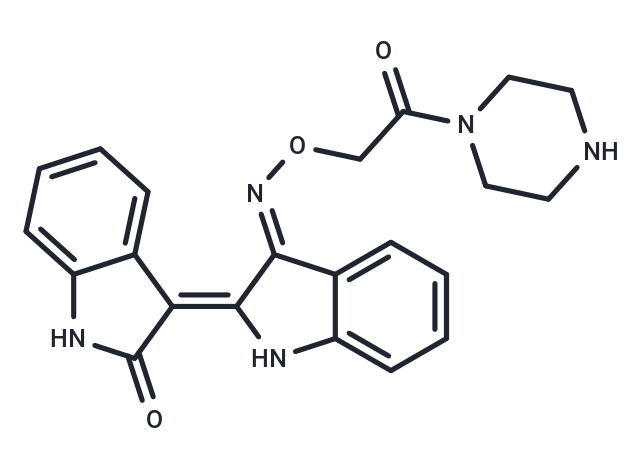Shopping Cart
Remove All Your shopping cart is currently empty
Your shopping cart is currently empty
FLT3/D835Y-IN-1 (compound 13a) is an orally active, selective inhibitor of FLT3 and FLT3/D835Y with IC50 values of 0.26 nM and 0.18 nM, respectively. It exhibits anticancer efficacy and has research value in AML (acute myeloid leukemia).

| Pack Size | Price | USA Warehouse | Global Warehouse | Quantity |
|---|---|---|---|---|
| 25 mg | $1,520 | 6-8 weeks | 6-8 weeks | |
| 50 mg | $1,980 | 6-8 weeks | 6-8 weeks | |
| 100 mg | $2,500 | 6-8 weeks | 6-8 weeks |
| Description | FLT3/D835Y-IN-1 (compound 13a) is an orally active, selective inhibitor of FLT3 and FLT3/D835Y with IC50 values of 0.26 nM and 0.18 nM, respectively. It exhibits anticancer efficacy and has research value in AML (acute myeloid leukemia). |
| Targets&IC50 | FLT3 (D835Y):0.18 nM |
| In vitro | FLT3/D835Y-IN-1 (compound 13a) at 100 nM for 3 hours effectively inhibits the proliferation of Ba/F3-FLT3-ITD, Ba/F3-FLT3-ITD/D835Y, Ba/F3-FLT3-ITD-F691L, and AML cells. At 3-30 nM for 16 hours, it markedly suppresses FLT3, AKT, ERK, and STAT5 signaling. A 100 nM 3-hour incubation resulted in significant inhibition with GI50 values of 0.59, 0.73, 5.54, 1.30, 6.20, and 4.58 nM. Western Blot analysis of MOLM14-ITD/D835Y and MOLM14-ITD/F691L cells treated with 3, 10, and 30 nM for 16 hours showed a significant reduction in FLT3, AKT, ERK, and STAT5 pathway activities at lower doses. |
| In vivo | Administering FLT3/D835Y-IN-1 at a dosage of 10 mg/kg interperitoneally (IP) daily for six days per week notably inhibits tumor proliferation and demonstrates strong antitumor efficacy against MOLM14-ITD/D835Y cells. Conversely, administering a single dose of 10 mg/kg intravenously (IV) or orally reveals a considerably low area under the curve (AUC) and elevated clearance rates in pharmacokinetic studies, indicating rapid drug elimination. Additionally, pharmacokinetic parameters assessed in ICR mice include an AUC of 1360 ± 110 ng*h/mL, clearance rate (CL) of 6.96 ± 0.66 L/h/kg, steady-state volume of distribution (Vss) of 14.8 ± 0.7 L/kg, and a half-life (T1/2) of 1.5 ± 0.1 hours. In trials involving NOD/SCID mice (9 per group, 6 weeks old, male), the compound significantly reduced tumor size when given IP daily at 10 mg/kg from day 7 to 29. Similarly, in ICR mice (7–8 weeks old, male), a single dose of the compound, dissolved in 10% DMSO, 40% PEG400, and 50% PBS, administered IV or orally showed significantly low AUC and high clearance. |
| Molecular Weight | 403.43 |
| Formula | C22H21N5O3 |
| Cas No. | 2648799-49-7 |
| Smiles | O=C1\C(\C=2C(N1)=CC=CC2)=C/3\C(=N\OCC(=O)N4CCNCC4)\C=5C(N3)=CC=CC5 |
| Storage | Powder: -20°C for 3 years | In solvent: -80°C for 1 year | Shipping with blue ice/Shipping at ambient temperature. |
| Size | Quantity | Unit Price | Amount | Operation |
|---|

Copyright © 2015-2026 TargetMol Chemicals Inc. All Rights Reserved.